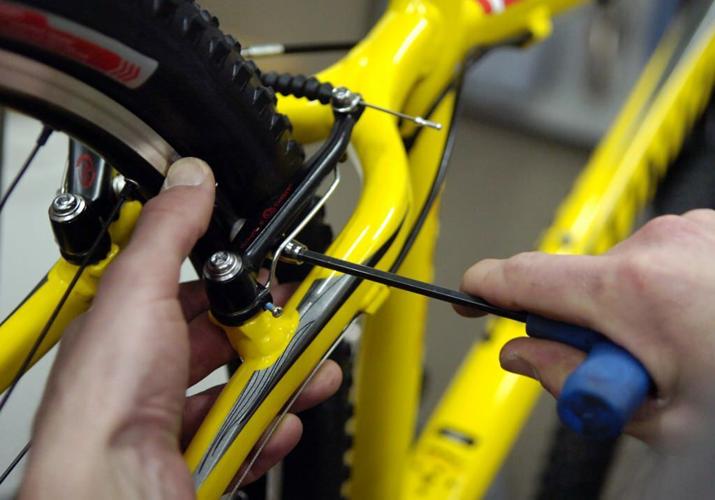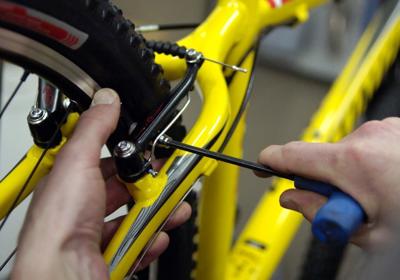You can help prolong the life of your bicycle by following regular basic maintenance. You can save money by maintaining your bike between visits to your mechanic. You should know how to clean your bike, secure bolts and lubricate key components.
How to clean your bike
In general, it’s OK to gently hose off your bike – but don’t power wash it. Most dirty bike components can be cleaned by wiping them with a damp rag. Other components require occasional brushing, buffing and lubrication.
Few cyclists clean their bikes after every ride. But it’s a good idea to clean your bike after a particularly muddy ride and to set up a regular schedule of cleaning (every weekend, at the end of every month).

Rather than simply spraying your bike with a hose, mechanics recommend you wet it and wipe it with a cloth.
Basic Cleaning Supplies
These simple items address most cleaning tasks: Clean rags: Keep plenty of these on hand for grease, oil and wax-related tasks and for general cleaning and drying. Soap: Use diluted dishwashing soap or preformulated bike wash cleaner for frame cleaning. Brushes: Have several sizes and shapes to get into hard-to-reach places to remove the grime that rinsing alone can’t get. Old toothbrushes work great. Solvents: A general or bike-specific solvent (avoid kerosene and turpentine) will clean up gummy parts like your bike chain. Choose a solvent that is easy on the environment.
Securing Bike Bolts
Bicycles are held together by dozens of nuts, bolts and screws. Maintaining a “tight ship” is important because loose bike parts can cause poor performance, lead to wear and tear, and become a safety hazard.
Take care, over-tightening can lead to component damage or failure. Consult your owner’s manual for proper torque specs.
The Pre-ride Inspection
The best defense against loose components is a routine inspection before every ride. This will help you catch potential problems (rattles, squeaks, wobbles) before they develop into safety hazards. Most pre-ride inspection adjustments can be made with a simple bike multi-tool.
The Bike Shop Visit
Don’t overlook regular maintenance by bike pros. If you’re a regular rider, take your bike in for twice-yearly checkups to ensure that complex, hard-to-evaluate components such as spokes, bearing surfaces, derailleurs and cable systems are inspected and serviced regularly.

Bike mechanic Chris Kuhn lubricates the chain of a mountain bike he is prepping for riding season.
Lubricating Your Bike
Keeping your bike parts properly lubricated is crucial for good performance. Lubrication protects moving parts from excessive wear, keeps them from “freezing up” and keeps rust and corrosion at bay.
Be careful to wipe off excess lube to avoid attracting dirt and other abrasive particles.
Lubricant Options
Check with your local bike shop/mechanic for recommendations on bicycle greases (used primarily on bearing systems and large-thread bolts) and oils (used on thin-thread bolts, chains and moving parts in brake and derailleur systems).
What Needs to Be Lubricated?
Chain: Your chain is your bike’s most “at risk” lubricated part. Lube it frequently to slow the rate of chain wear. More occasionally you should remove the chain from your bike to be thoroughly cleaned in a solvent and re-oiled. The more frequently you spot-lube your chain, the less necessary off-bike cleanings (and chain replacements) become. In general, lubricate your chain whenever it squeaks or appears “dry.” Lubing after wet rides will help keep your chain from rusting. Avoid over-lubricating. Brake and derailleur levers: Apply a drop or two of oil to the lever pivots and the barrel adjusters periodically to keep them functioning properly. Brake and derailleur cables: Check them frequently (especially in wet conditions) and re-lubricate occasionally so that they can effectively translate your commands to the component groups. Brake and derailleur assemblies: These consist of a number of small moving parts. Keep an eye on their arms, wheels and pulleys so they don’t bind up or become rigid. Apply lubricant to the pivot points. Bearing systems: The subject of maintenance and repair for hubs, headsets and cranksets is beyond the scope of this introductory article.










(0) comments
Welcome to the discussion.
Log In
Keep it Clean. Please avoid obscene, vulgar, lewd, racist or sexually-oriented language.
PLEASE TURN OFF YOUR CAPS LOCK.
Don't Threaten. Threats of harming another person will not be tolerated.
Be Truthful. Don't knowingly lie about anyone or anything.
Be Nice. No racism, sexism or any sort of -ism that is degrading to another person.
Be Proactive. Use the 'Report' link on each comment to let us know of abusive posts.
Share with Us. We'd love to hear eyewitness accounts, the history behind an article.